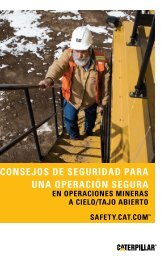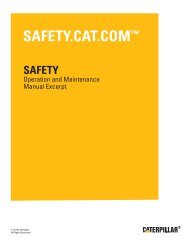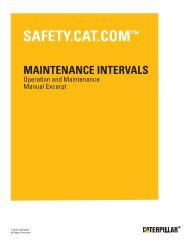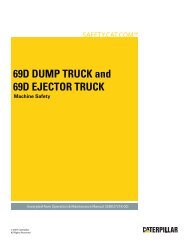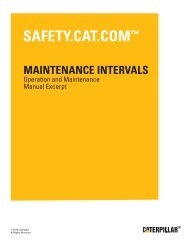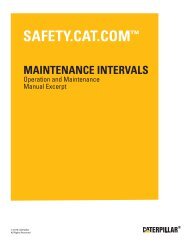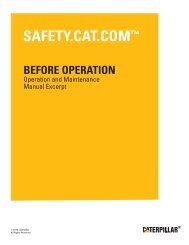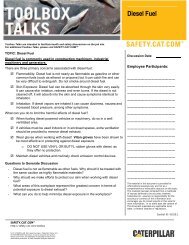r1300g load haul dump-machine safety - Caterpillar Safety
r1300g load haul dump-machine safety - Caterpillar Safety
r1300g load haul dump-machine safety - Caterpillar Safety
You also want an ePaper? Increase the reach of your titles
YUMPU automatically turns print PDFs into web optimized ePapers that Google loves.
R1300G LOAD<br />
HAUL DUMP<br />
Machine <strong>Safety</strong><br />
© 2007 <strong>Caterpillar</strong><br />
All Rights Reserved<br />
SAFETY.CAT.COM<br />
Excerpted from Operation & Maintenance Manual ((SEBU7329-01)<br />
®
Important <strong>Safety</strong> Information<br />
i01658146<br />
Most accidents that involve product operation, maintenance and repair are caused by failure to<br />
observe basic <strong>safety</strong> rules or precautions. An accident can often be avoided by recognizing potentially<br />
hazardous situations before an accident occurs. A person must be alert to potential hazards. This<br />
person should also have the necessary training, skills and tools to perform these functions properly.<br />
Improper operation, lubrication, maintenance or repair of this product can be dangerous and<br />
could result in injury or death.<br />
Do not operate or perform any lubrication, maintenance or repair on this product, until you have<br />
read and understood the operation, lubrication, maintenance and repair information.<br />
<strong>Safety</strong> precautions and warnings are provided in this manual and on the product. If these hazard<br />
warnings are not heeded, bodily injury or death could occur to you or to other persons.<br />
The hazards are identified by the “<strong>Safety</strong> Alert Symbol” and followed by a “Signal Word” such as<br />
“DANGER”, “WARNING” or “CAUTION”. The <strong>Safety</strong> Alert “WARNING” label is shown below.<br />
The meaning of this <strong>safety</strong> alert symbol is as follows:<br />
Attention! Become Alert! Your <strong>Safety</strong> is Involved.<br />
The message that appears under the warning explains the hazard and can be either written or<br />
pictorially presented.<br />
Operations that may cause product damage are identified by “NOTICE” labels on the product and in<br />
this publication.<br />
<strong>Caterpillar</strong> cannot anticipate every possible circumstance that might involve a potential hazard. The<br />
warnings in this publication and on the product are, therefore, not all inclusive. If a tool, procedure,<br />
work method or operating technique that is not specifically recommended by <strong>Caterpillar</strong> is used,<br />
you must satisfy yourself that it is safe for you and for others. You should also ensure that the<br />
product will not be damaged or be made unsafe by the operation, lubrication, maintenance or<br />
repair procedures that you choose.<br />
The information, specifications, and illustrations in this publication are on the basis of information that<br />
was available at the time that the publication was written. The specifications, torques, pressures,<br />
measurements, adjustments, illustrations, and other items can change at any time. These changes can<br />
affect the service that is given to the product. Obtain the complete and most current information before<br />
you start any job. <strong>Caterpillar</strong> dealers have the most current information available.<br />
When replacement parts are required for this<br />
product <strong>Caterpillar</strong> recommends using <strong>Caterpillar</strong><br />
replacement parts or parts with equivalent<br />
specifications including, but not limited to, physical<br />
dimensions, type, strength and material.<br />
Failure to heed this warning can lead to premature<br />
failures, product damage, personal injury or<br />
death.
6<br />
<strong>Safety</strong> Section<br />
<strong>Safety</strong> Signs and Labels<br />
<strong>Safety</strong> Section<br />
<strong>Safety</strong> Signs and Labels<br />
SMCS Code: 7000; 7405<br />
i01909390<br />
There are several specific <strong>safety</strong> signs on this<br />
<strong>machine</strong>. The exact location of the hazards and<br />
the description of the hazards are reviewed in this<br />
section. Please become familiarized with all <strong>safety</strong><br />
signs.<br />
Make sure that all of the <strong>safety</strong> signs are legible.<br />
Clean the <strong>safety</strong> signs or replace the <strong>safety</strong> signs if<br />
you cannot read the words. Replace the illustrations<br />
if the illustrations are not legible. When you clean<br />
the <strong>safety</strong> signs, use a cloth, water and soap. Do<br />
not use solvent, gasoline, or other harsh chemicals<br />
to clean the <strong>safety</strong> signs. Solvents, gasoline, or<br />
harsh chemicals could loosen the adhesive that<br />
secures the <strong>safety</strong> sign. Loose adhesive will allow<br />
the <strong>safety</strong> sign to fall.<br />
Replace any <strong>safety</strong> sign that is damaged, or<br />
missing. If a <strong>safety</strong> sign is attached to a part that is<br />
replaced, install a <strong>safety</strong> sign on the replacement<br />
part. Any <strong>Caterpillar</strong> dealer can provide new <strong>safety</strong><br />
signs.<br />
Do Not Operate<br />
Illustration 2<br />
g00994953<br />
This <strong>safety</strong> label is located in the operator station.<br />
Illustration 3<br />
g00891950<br />
Do not operate or work on this <strong>machine</strong> unless you<br />
have read and understand the instructions and<br />
warnings in the Operation and Maintenance Manuals.<br />
Failure to follow the instructions or heed the<br />
warnings could result in injury or death. Contact<br />
your <strong>Caterpillar</strong> dealer for replacement manuals.<br />
Proper care is your responsibility.<br />
Do Not Weld the ROPS<br />
Illustration 4<br />
g00994954<br />
This <strong>safety</strong> label is located in the operator station.
Illustration 5<br />
g00892002<br />
Structural damage, an overturn, modification, alteration,<br />
or improper repair can impair this structure’s<br />
protection capability thereby voiding this<br />
certification. Do not weld on or drill holes in the<br />
structure. Consult an Elphinstone dealer to determine<br />
this structure’s limitations without voiding<br />
its certification.<br />
Rollover and Falling Object Protective<br />
Structure Certification<br />
This structure, when properly installed on a <strong>machine</strong><br />
which is not altered to exceed the certification test<br />
weight meets, at the time of installation, criteria<br />
established by: C.S.A B352-1990, SAEJ231-1981,<br />
SAEJ1040-1994, ISO 3449-1992, AS2294-1997<br />
FOPS LEVEL II, AS2294-1997 ROPS, ISO<br />
3471/1-1994.<br />
No Clearance<br />
Illustration 6<br />
g00994955<br />
This <strong>safety</strong> label is located on both sides of the<br />
<strong>machine</strong> articulating hitch.<br />
Illustration 7<br />
7<br />
<strong>Safety</strong> Section<br />
<strong>Safety</strong> Signs and Labels<br />
g00892055<br />
No clearance for person in this area when <strong>machine</strong><br />
turns. Severe injury or death from crushing<br />
could occur. Connect steering frame lock between<br />
front and rear frames before lifting, transporting,<br />
or servicing <strong>machine</strong> in articulation area. Disconnect<br />
lock and secure before resuming operation.<br />
STIC Steering Control<br />
Illustration 8<br />
This <strong>safety</strong> label is located on the inside of the<br />
operator station door.<br />
g00994956
8<br />
<strong>Safety</strong> Section<br />
<strong>Safety</strong> Signs and Labels<br />
Illustration 9<br />
g00892146<br />
Use grab handle not STIC control when entering<br />
or leaving operator’s station.<br />
Severe injury or death may be caused by crushing<br />
when <strong>machine</strong> turns<br />
Operator Station Access<br />
Illustration 10<br />
This <strong>safety</strong> label is located on the inside of the<br />
operator station door.<br />
g00994957<br />
Illustration 11<br />
g00892207<br />
No clearance for person in operator’s station access<br />
area when <strong>machine</strong> turns. Severe injury or<br />
death from crushing could occur.<br />
Engage transmission/primary steering lock before<br />
leaving the operator’s station.<br />
Bucket Control Group<br />
Illustration 12<br />
g00994958<br />
This <strong>safety</strong> label is located on both sides of the<br />
lift arm.
Illustration 13<br />
g00892335<br />
No clearance for person in this area when bucket<br />
control group lowers. Severe injury or death from<br />
crushing could occur.<br />
Install bucket control group <strong>safety</strong> pins before servicing<br />
<strong>machine</strong> in this area.<br />
Remove <strong>safety</strong> pins and secure before resuming<br />
operation.<br />
High Pressure Cylinder (Ride<br />
Control)<br />
Illustration 14<br />
g00994959<br />
This <strong>safety</strong> label is located on the front frame near<br />
the ride control accumulator (if equipped).<br />
Illustration 15<br />
High Pressure Cylinder!<br />
9<br />
<strong>Safety</strong> Section<br />
<strong>Safety</strong> Signs and Labels<br />
g00892476<br />
Do not remove any valve, hydraulic fitting, or valve<br />
core, nor disassemble any parts until pressure<br />
has been relieved, or personal injury may occur.<br />
To relieve pressure:<br />
1. Refer to the Service Manual for the correct<br />
method of dissipating hydraulic system<br />
pressure.<br />
2. Relieve gas pressure in the accumulator<br />
cylinder by opening the charging valve one<br />
turn only.<br />
Charge the cylinder with dry nitrogen gas.<br />
See your <strong>Caterpillar</strong> dealer for tools and detailed<br />
information required for charging cylinders.<br />
High Pressure Cylinder (Brake<br />
Accumulator)<br />
Illustration 16<br />
g00994960
10<br />
<strong>Safety</strong> Section<br />
<strong>Safety</strong> Signs and Labels<br />
This <strong>safety</strong> label is located near the brake<br />
accumulator.<br />
Illustration 17<br />
High Pressure Cylinder!<br />
g00892403<br />
Do not remove any valve, hydraulic fitting, or valve<br />
core, nor disassemble any parts until pressure<br />
has been relieved, or personal injury may occur.<br />
To relieve pressure:<br />
1. Refer to the Service Manual for the correct<br />
method of dissipating hydraulic system<br />
pressure.<br />
2. Relieve gas pressure in the accumulator<br />
cylinder by opening the charging valve one<br />
turn only.<br />
Charge the cylinder with dry nitrogen gas.<br />
See your <strong>Caterpillar</strong> dealer for tools and detailed<br />
information required for charging cylinders.<br />
Batteries<br />
Illustration 18<br />
g00994961<br />
This <strong>safety</strong> label is located on the right side of the<br />
battery compartment.<br />
Illustration 19<br />
g00892563<br />
IMPROPER JUMPER CABLE CONNECTIONS CAN<br />
CAUSE EXPLOSION RESULTING IN PERSONAL<br />
INJURY.<br />
BATTERIES MAY BE LOCATED IN SEPARATE<br />
COMPARTMENTS. WHEN USING JUMPER CA-<br />
BLES, ALWAYS CONNECT POSITIVE (+) CABLE<br />
TO POSITIVE (+) TERMINAL OF BATTERY CON-<br />
NECTED TO STARTER SOLENOID AND NEGA-<br />
TIVE (-) CABLE FROM EXTERNAL SOURCE TO<br />
STARTER NEGATIVE (-) TERMINAL (IF MACHINE<br />
NOT EQUIPPED WITH STARTER NEGATIVE TER-<br />
MINAL, CONNECT TO ENGINE BLOCK.) FOLLOW<br />
PROCEDURE IN THE OPERATION MANUAL.
Engine Coolant<br />
Illustration 20<br />
g00994962<br />
This <strong>safety</strong> label is located near the cooling system<br />
pressure cap.<br />
Illustration 21<br />
g00892607<br />
PRESSURIZED SYSTEM: HOT COOLANT CAN<br />
CAUSE SERIOUS BURN. TO OPEN CAP, STOP<br />
ENGINE, WAIT UNTIL RADIATOR IS COOL. THEN<br />
LOOSEN CAP SLOWLY TO RELIEVE THE PRES-<br />
SURE.<br />
Compressed Spring<br />
Illustration 22<br />
11<br />
<strong>Safety</strong> Section<br />
<strong>Safety</strong> Signs and Labels<br />
g00994963<br />
This <strong>safety</strong> label is located on the brake release<br />
cylinder (if equipped).<br />
Illustration 23<br />
g00100414<br />
Personal injury can result from spring force released<br />
when removing cap screws.<br />
Internal spring force will be released when cylinder<br />
assembly cap screws are removed causing injury.<br />
Always restrain cover as cap screws are loosened.<br />
Follow the established procedure in the Service<br />
Manual to service these parts.
12<br />
<strong>Safety</strong> Section<br />
General Hazard Information<br />
Recovery Hook<br />
Illustration 24<br />
g00994964<br />
This <strong>safety</strong> label is located next to the recovery<br />
hook (if equipped).<br />
Illustration 25<br />
g00946835<br />
Do not use this recovery device for towing other<br />
<strong>machine</strong>s or equipment.<br />
Use of this hook may disengage the parking/secondary<br />
brake.<br />
Personal injury or death from run over could result.<br />
Marked tow devices should be used to tow other<br />
<strong>machine</strong>s.<br />
i01426767<br />
General Hazard Information<br />
SMCS Code: 7000<br />
Illustration 26<br />
g00104545<br />
Attach a “Do Not Operate” warning tag or a similar<br />
warning tag to the start switch or to the controls<br />
before you service the equipment or before you<br />
repair the equipment. These warning tags (Special<br />
Instruction, SEHS7332) are available from your<br />
<strong>Caterpillar</strong> dealer.<br />
Know the width of your equipment in order to<br />
maintain proper clearance when you operate the<br />
equipment near fences or near boundary obstacles.<br />
Be aware of high voltage power lines and power<br />
cables that are buried. If the <strong>machine</strong> comes in<br />
contact with these hazards, serious injury or death<br />
may occur from electrocution.<br />
Illustration 27<br />
Wear a hard hat, protective glasses, and other<br />
protective equipment, as required.<br />
g00702020<br />
Do not wear loose clothing or jewelry that can snag<br />
on controls or on other parts of the equipment.<br />
Make sure that all protective guards and all covers<br />
are secured in place on the equipment.
Keep the equipment free from foreign material.<br />
Remove debris, oil, tools, and other items from the<br />
deck, from walkways, and from steps.<br />
Secure all loose items such as lunch boxes, tools,<br />
and other items that are not a part of the equipment.<br />
Know the appropriate work site hand signals and<br />
the personnel that are authorized to give the hand<br />
signals. Accept hand signals from one person only.<br />
Do not smoke when you service an air conditioner.<br />
Also, do not smoke if refrigerant gas may be<br />
present. Inhaling the fumes that are released from a<br />
flame that contacts air conditioner refrigerant can<br />
cause bodily harm or death. Inhaling gas from air<br />
conditioner refrigerant through a lighted cigarette<br />
can cause bodily harm or death.<br />
Never put maintenance fluids into glass containers.<br />
Drain all liquids into a suitable container.<br />
Obey all local regulations for the disposal of liquids.<br />
Use all cleaning solutions with care. Report all<br />
necessary repairs.<br />
Do not allow unauthorized personnel on the<br />
equipment.<br />
Unless you are instructed otherwise, perform<br />
maintenance with the equipment in the servicing<br />
position. Refer to Operation and Maintenance<br />
Manual for the procedure for placing the equipment<br />
in the servicing position.<br />
Pressure Air and Water<br />
Pressurized air and/or water can cause debris<br />
and/or hot water to be blown out. This could result<br />
in personal injury.<br />
When pressure air and/or pressure water is used<br />
for cleaning, wear protective clothing, protective<br />
shoes, and eye protection. Eye protection includes<br />
goggles or a protective face shield.<br />
The maximum air pressure for cleaning purposes<br />
must be below 205 kPa (30 psi). The maximum<br />
water pressure for cleaning purposes must be<br />
below 275 kPa (40 psi).<br />
Trapped Pressure<br />
13<br />
<strong>Safety</strong> Section<br />
General Hazard Information<br />
Pressure can be trapped in a hydraulic system.<br />
Releasing trapped pressure can cause sudden<br />
<strong>machine</strong> movement or attachment movement. Use<br />
caution if you disconnect hydraulic lines or fittings.<br />
High pressure oil that is released can cause a hose<br />
to whip. High pressure oil that is released can<br />
cause oil to spray. Fluid penetration can cause<br />
serious injury and possible death.<br />
Fluid Penetration<br />
Pressure can be trapped in the hydraulic circuit<br />
long after the engine has been stopped. The<br />
pressure can cause hydraulic fluid or items such<br />
as pipe plugs to escape rapidly if the pressure is<br />
not relieved correctly.<br />
Do not remove any hydraulic components or parts<br />
until pressure has been relieved or personal injury<br />
may occur. Do not disassemble any hydraulic<br />
components or parts until pressure has been<br />
relieved or personal injury may occur. Refer to the<br />
Service Manual for any procedures that are required<br />
to relieve the hydraulic pressure.<br />
Illustration 28<br />
g00687600<br />
Always use a board or cardboard when you check<br />
for a leak. Leaking fluid that is under pressure can<br />
penetrate body tissue. Fluid penetration can cause<br />
serious injury and possible death. A pin hole leak<br />
can cause severe injury. If fluid is injected into your<br />
skin, you must get treatment immediately. Seek<br />
treatment from a doctor that is familiar with this type<br />
of injury.<br />
Containing Fluid Spillage<br />
Care must be taken in order to ensure that fluids<br />
are contained during performance of inspection,<br />
maintenance, testing, adjusting and repair of the<br />
equipment. Prepare to collect the fluid with suitable<br />
containers before opening any compartment or<br />
disassembling any component containing fluids.
14<br />
<strong>Safety</strong> Section<br />
Crushing Prevention and Cutting Prevention<br />
Refer to Special Publication, NENG2500, “Tools and<br />
Shop Products Guide” for the following items:<br />
Tools that are suitable for collecting fluids and<br />
equipment that is suitable for collecting fluids<br />
Tools that are suitable for containing fluids and<br />
equipment that is suitable for containing fluids<br />
Obey all local regulations for the disposal of liquids.<br />
Asbestos Information<br />
Illustration 29<br />
g00702022<br />
<strong>Caterpillar</strong> equipment and replacement parts that<br />
are shipped from <strong>Caterpillar</strong> are asbestos free.<br />
<strong>Caterpillar</strong> recommends the use of only genuine<br />
<strong>Caterpillar</strong> replacement parts. Use the following<br />
guidelines when you handle any replacement parts<br />
that contain asbestos or when you handle asbestos<br />
debris.<br />
Use caution. Avoid inhaling dust that might be<br />
generated when you handle components that<br />
contain asbestos fibers. Inhaling this dust can<br />
be hazardous to your health. The components<br />
that may contain asbestos fibers are brake pads,<br />
brake bands, lining material, clutch plates, and<br />
some gaskets. The asbestos that is used in these<br />
components is usually bound in a resin or sealed in<br />
some way. Normal handling is not hazardous unless<br />
airborne dust that contains asbestos is generated.<br />
If dust that may contain asbestos is present, there<br />
are several guidelines that should be followed:<br />
Never use compressed air for cleaning.<br />
Avoid brushing materials that contain asbestos.<br />
Avoid grinding materials that contain asbestos.<br />
Use a wet method in order to clean up asbestos<br />
materials.<br />
A vacuum cleaner that is equipped with a high<br />
efficiency particulate air filter (HEPA) can also be<br />
used.<br />
Use exhaust ventilation on permanent machining<br />
jobs.<br />
Wear an approved respirator if there is no other<br />
way to control the dust.<br />
Comply with applicable rules and regulations<br />
for the work place. In the United States, use<br />
Occupational <strong>Safety</strong> and Health Administration<br />
(OSHA) requirements. These OSHA requirements<br />
can be found in “29 CFR 1910.1001”.<br />
Obey environmental regulations for the disposal<br />
of asbestos.<br />
Stay away from areas that might have asbestos<br />
particles in the air.<br />
Dispose of Waste Properly<br />
Illustration 30<br />
g00706404<br />
Improperly disposing of waste can threaten the<br />
environment. Potentially harmful fluids should be<br />
disposed of according to local regulations.<br />
Always use leakproof containers when you drain<br />
fluids. Do not pour waste onto the ground, down a<br />
drain, or into any source of water.<br />
Crushing Prevention and<br />
Cutting Prevention<br />
SMCS Code: 7000<br />
i01359664<br />
Support the equipment properly before you perform<br />
any work or maintenance beneath that equipment.<br />
Do not depend on the hydraulic cylinders to hold<br />
up the equipment. Equipment can fall if a control is<br />
moved, or if a hydraulic line breaks.
Do not work beneath the cab of the <strong>machine</strong> unless<br />
the cab is properly supported.<br />
Unless you are instructed otherwise, never attempt<br />
adjustments while the <strong>machine</strong> is moving or while<br />
the engine is running.<br />
Never jump across the starter solenoid terminals<br />
in order to start the engine. Unexpected <strong>machine</strong><br />
movement could result.<br />
Whenever there are equipment control linkages the<br />
clearance in the linkage area will change with the<br />
movement of the equipment or the <strong>machine</strong>. Stay<br />
clear of areas that may have a sudden change in<br />
clearance with <strong>machine</strong> movement or equipment<br />
movement.<br />
Stay clear of all rotating and moving parts.<br />
If it is necessary to remove guards in order to<br />
perform maintenance, always install the guards<br />
after the maintenance is performed.<br />
Keep objects away from moving fan blades. The<br />
fan blade will throw objects or cut objects.<br />
Do not use a kinked wire cable or a frayed wire<br />
cable. Wear gloves when you handle wire cable.<br />
When you strike a retainer pin with force, the<br />
retainer pin can fly out. The loose retainer pin can<br />
injure personnel. Make sure that the area is clear<br />
of people when you strike a retainer pin. To avoid<br />
injury to your eyes, wear protective glasses when<br />
you strike a retainer pin.<br />
Chips or other debris can fly off an object when<br />
you strike the object. Make sure that no one can be<br />
injured by flying debris before striking any object.<br />
Burn Prevention<br />
SMCS Code: 7000<br />
i01329099<br />
Do not touch any part of an operating engine.<br />
Allow the engine to cool before any maintenance is<br />
performed on the engine. Relieve all pressure in<br />
the air system, in the oil system, in the lubrication<br />
system, in the fuel system, or in the cooling system<br />
before any lines, fittings or related items are<br />
disconnected.<br />
Coolant<br />
When the engine is at operating temperature, the<br />
engine coolant is hot. The coolant is also under<br />
pressure. The radiator and all lines to the heaters or<br />
to the engine contain hot coolant.<br />
15<br />
<strong>Safety</strong> Section<br />
Burn Prevention<br />
Any contact with hot coolant or with steam<br />
can cause severe burns. Allow cooling system<br />
components to cool before the cooling system is<br />
drained.<br />
Check the coolant level only after the engine has<br />
been stopped.<br />
Ensure that the filler cap is cool before removing<br />
the filler cap. The filler cap must be cool enough<br />
to touch with a bare hand. Remove the filler cap<br />
slowly in order to relieve pressure.<br />
Cooling system conditioner contains alkali. Alkali<br />
can cause personal injury. Do not allow alkali to<br />
contact the skin, the eyes, or the mouth.<br />
Oils<br />
Hot oil and hot components can cause personal<br />
injury. Do not allow hot oil to contact the skin. Also,<br />
do not allow hot components to contact the skin.<br />
Remove the hydraulic tank filler cap only after the<br />
engine has been stopped. The filler cap must be<br />
cool enough to touch with a bare hand. Follow<br />
the standard procedure in this manual in order to<br />
remove the hydraulic tank filler cap.<br />
Batteries<br />
Electrolyte is an acid. Electrolyte can cause<br />
personal injury. Do not allow electrolyte to contact<br />
the skin or the eyes. Always wear protective glasses<br />
for servicing batteries. Wash hands after touching<br />
the batteries and connectors. Use of gloves is<br />
recommended.<br />
i01359795<br />
Fire Prevention and Explosion<br />
Prevention<br />
SMCS Code: 7000<br />
Illustration 31<br />
g00704000
16<br />
<strong>Safety</strong> Section<br />
Fire Prevention and Explosion Prevention<br />
All fuels, most lubricants, and some coolant mixtures<br />
are flammable.<br />
Flammable fluids that are leaking or spilled onto hot<br />
surfaces or onto electrical components can cause<br />
a fire. Fire may cause personal injury and property<br />
damage.<br />
Remove all flammable materials such as fuel, oil,<br />
and debris from the <strong>machine</strong>. Do not allow any<br />
flammable materials to accumulate on the <strong>machine</strong>.<br />
Store fuels and lubricants in properly marked<br />
containers away from unauthorized persons. Store<br />
oily rags and any flammable materials in protective<br />
containers. Do not smoke in areas that are used for<br />
storing flammable materials.<br />
Do not operate the <strong>machine</strong> near any flame.<br />
Exhaust shields (if equipped) protect hot exhaust<br />
components from oil spray or fuel spray in case of<br />
a break in a line, in a hose, or in a seal. Exhaust<br />
shields must be installed correctly.<br />
Do not weld on lines or on tanks that contain<br />
flammable fluids. Do not flame cut lines or tanks<br />
that contain flammable fluid. Clean any such lines<br />
or tanks thoroughly with a nonflammable solvent<br />
prior to welding or flame cutting.<br />
Check all electrical wires daily. Repair any wires that<br />
are loose or frayed before you operate the <strong>machine</strong>.<br />
Clean all electrical connections and tighten all<br />
electrical connections.<br />
Dust that is generated from repairing nonmetallic<br />
hoods or nonmetallic fenders can be flammable<br />
and/or explosive. Repair such components in a well<br />
ventilated area away from open flames or sparks.<br />
Inspect all lines and hoses for wear or for<br />
deterioration. The hoses must be properly routed.<br />
The lines and the hoses must have adequate<br />
support and secure clamps. Tighten all connections<br />
to the recommended torque. Leaks can cause fires.<br />
Illustration 32<br />
g00704059<br />
Use caution when you are refueling a <strong>machine</strong>. Do<br />
not smoke while you are refueling a <strong>machine</strong>. Do<br />
not refuel a <strong>machine</strong> near open flames or sparks.<br />
Always stop the engine before refueling. Fill the fuel<br />
tank outdoors.<br />
Illustration 33<br />
g00704135<br />
Gases from a battery can explode. Keep any open<br />
flames or sparks away from the top of a battery. Do<br />
not smoke in battery charging areas.<br />
Never check the battery charge by placing a metal<br />
object across the terminal posts. Use a voltmeter or<br />
a hydrometer.
Improper jumper cable connections can cause<br />
an explosion that can result in injury. Refer to<br />
the Operation Section of this manual for specific<br />
instructions.<br />
Do not charge a frozen battery. This may cause<br />
an explosion.<br />
Fire Extinguisher<br />
Make sure that a fire extinguisher is available. Be<br />
familiar with the operation of the fire extinguisher.<br />
Inspect the fire extinguisher and service the fire<br />
extinguisher regularly. Obey the recommendations<br />
on the instruction plate.<br />
Ether<br />
Ether is flammable and poisonous.<br />
Use ether in well ventilated areas. Do not smoke<br />
while you are replacing an ether cylinder or while<br />
you are using an ether spray.<br />
Do not store ether cylinders in living areas or in the<br />
operator compartment of a <strong>machine</strong>. Do not store<br />
ether cylinders in direct sunlight or in temperatures<br />
above 49 C (120 F). Keep ether cylinders away<br />
from open flames or sparks.<br />
Dispose of used ether cylinders properly. Do not<br />
puncture an ether cylinder. Keep ether cylinders<br />
away from unauthorized personnel.<br />
Do not spray ether into an engine if the <strong>machine</strong><br />
is equipped with a thermal starting aid for cold<br />
weather starting.<br />
Lines, Tubes and Hoses<br />
Do not bend high pressure lines. Do not strike high<br />
pressure lines. Do not install any lines that are bent<br />
or damaged.<br />
Repair any lines that are loose or damaged. Leaks<br />
can cause fires. Consult your <strong>Caterpillar</strong> dealer for<br />
repair or for replacement parts.<br />
Check lines, tubes and hoses carefully. Do not<br />
use your bare hand to check for leaks. Use a<br />
board or cardboard to check for leaks. Tighten all<br />
connections to the recommended torque.<br />
Replace the parts if any of the following conditions<br />
are present:<br />
End fittings are damaged or leaking.<br />
Outer coverings are chafed or cut.<br />
Wires are exposed.<br />
Outer coverings are ballooning.<br />
17<br />
<strong>Safety</strong> Section<br />
Fire Extinguisher Location<br />
Flexible part of the hoses are kinked.<br />
Outer covers have embedded armoring.<br />
End fittings are displaced.<br />
Make sure that all clamps, guards, and heat shields<br />
are installed correctly. During <strong>machine</strong> operation,<br />
this will help to prevent vibration, rubbing against<br />
other parts, and excessive heat.<br />
i01909921<br />
Fire Extinguisher Location<br />
SMCS Code: 7000; 7419<br />
Make sure that a fire extinguisher is on the <strong>machine</strong>.<br />
Make sure that you are familiar with the operation<br />
of the fire extinguisher. Inspect the fire extinguisher<br />
and service the fire extinguisher on a regular basis.<br />
Obey the recommendations on the instruction plate.<br />
If equipped, know how to use the <strong>machine</strong> fire<br />
suppression system.<br />
Illustration 34<br />
g00995245<br />
The fire extinguisher should be mounted on the left<br />
side of the radiator guard. This is the recommended<br />
location. Do not weld the ROPS in order to install<br />
the fire extinguisher. Also, do not drill holes in the<br />
ROPS in order to mount the fire extinguisher.
18<br />
<strong>Safety</strong> Section<br />
Tire Information<br />
Illustration 35<br />
g00995244<br />
If more than one fire extinguisher is required,<br />
the recommended place to mount a second fire<br />
extinguisher is on the right side of the front frame.<br />
Tire Information<br />
SMCS Code: 7000<br />
i01557411<br />
Explosions of air inflated tires have resulted from<br />
heat-induced gas combustion inside the tires.<br />
Explosions can be caused by heat that is generated<br />
by welding, by heating rim components, by external<br />
fire, or by excessive use of brakes.<br />
A tire explosion is much more violent than a<br />
blowout. The explosion can propel the tire, the rim<br />
components, and the axle components as far as<br />
500 m (1500 ft) or more from the <strong>machine</strong>. Both the<br />
force of the explosion and the flying debris can<br />
cause property damage, personal injury, or death.<br />
Illustration 36<br />
(A) At least 15 m (50 ft)<br />
(B) At least 500 m (1500 ft)<br />
g00337832<br />
Do not approach a warm tire. Maintain a minimum<br />
distance, as shown. Stay outside the shaded area<br />
in Illustration 36.<br />
Do not use water or calcium as a ballast for the<br />
tires. Dry nitrogen gas is recommended for inflation<br />
of tires. If the tires were originally inflated with air,<br />
nitrogen is still preferred for adjusting the pressure.<br />
Nitrogen mixes properly with air.<br />
Nitrogen inflated tires reduce the potential of a<br />
tire explosion because nitrogen does not aid<br />
combustion. Nitrogen helps to prevent oxidation of<br />
the rubber, deterioration of rubber, and corrosion<br />
of rim components.<br />
To avoid overinflation, proper nitrogen inflation<br />
equipment and training in the usage of the<br />
equipment are necessary. A tire blowout or a rim<br />
failure can result from improper equipment or from<br />
misused equipment.<br />
When you inflate a tire, stand behind the tread and<br />
use a self-attaching chuck.<br />
Servicing tires and rims can be dangerous. Only<br />
trained personnel that use proper tools and proper<br />
procedures should perform this maintenance. If<br />
correct procedures are not used for servicing tires<br />
and rims, the assemblies could burst with explosive<br />
force. This explosive force can cause serious<br />
personal injury or death. Carefully obey the specific<br />
instructions from your tire dealer.<br />
Electrical Storm Injury<br />
Prevention<br />
SMCS Code: 7000<br />
i01122596<br />
When lightning is striking in the vicinity of the<br />
<strong>machine</strong>, the operator should never attempt the<br />
following procedures:<br />
Mount the <strong>machine</strong>.<br />
Dismount the <strong>machine</strong>.<br />
If you are in the operator’s station during an<br />
electrical storm, stay in the operator’s station. If you<br />
are on the ground during an electrical storm, stay<br />
away from the vicinity of the <strong>machine</strong>.
i02006130<br />
Mounting and Dismounting<br />
SMCS Code: 7000<br />
Illustration 37<br />
g00037860<br />
Mount the <strong>machine</strong> and dismount the <strong>machine</strong><br />
only at locations that have steps and/or handholds.<br />
Before you mount the <strong>machine</strong>, clean the steps and<br />
the handholds. Inspect the steps and handholds.<br />
Make any necessary repairs.<br />
Face the <strong>machine</strong> whenever you mount the <strong>machine</strong><br />
and whenever you dismount the <strong>machine</strong>.<br />
Maintain a three-point contact with the steps and<br />
with the handholds.<br />
Note: Three-point contact can be two feet and one<br />
hand. Three-point contact can also be one foot and<br />
two hands.<br />
Do not mount a moving <strong>machine</strong>. Do not dismount<br />
a moving <strong>machine</strong>. Never jump off the <strong>machine</strong>.<br />
Do not carry tools or supplies when you try to<br />
mount the <strong>machine</strong> or when you try to dismount the<br />
<strong>machine</strong>. Use a hand line to pull equipment onto<br />
the platform. Ensure the steering and transmission<br />
lock lever is in the LOCKED position when you<br />
enter the operator compartment or when you exit<br />
the operator compartment. Do not use any controls<br />
as handholds.<br />
Alternate Exit<br />
Machines that are equipped with cabs may have<br />
alternate exits. For additional information on<br />
<strong>machine</strong>s that are equipped with alternate exits,<br />
see Operation and Maintenance Manual, “Alternate<br />
Exit”.<br />
Before Starting Engine<br />
SMCS Code: 1000; 7000<br />
Illustration 38<br />
19<br />
<strong>Safety</strong> Section<br />
Mounting and Dismounting<br />
i01909924<br />
g00995248<br />
Make sure the steering frame lock is stored in the<br />
unlocked position as shown. The steering frame<br />
lock must be removed to steer the <strong>machine</strong>.<br />
Note: Start the engine only from the operator station.<br />
Never short across the starter terminals or across<br />
the batteries. Shorting could bypass the engine<br />
neutral start system. Shorting could also damage<br />
the electrical system.<br />
Before you mount the <strong>machine</strong>, perform a<br />
walk around inspection. Look for any damaged<br />
components and leaks. Report discrepancies and<br />
make any necessary repairs before operating the<br />
<strong>machine</strong>.<br />
Reference: For more information, refer to the<br />
Operation and Maintenance Manual, “Walk Around<br />
Inspection” for the <strong>machine</strong> that is being serviced.<br />
When you enter the operator station, inspect the<br />
condition of the seat belt and the condition of the<br />
mounting hardware. Replace any damaged parts<br />
and any worn parts. Regardless of appearance,<br />
replace the seat belt after three years of use. Do not<br />
use a seat belt extension on a retractable seat belt.<br />
Adjust the seat so that full pedal travel can be<br />
achieved when the operator’s back is against the<br />
back of the seat.<br />
Make sure that the <strong>machine</strong> is equipped with<br />
a lighting system that is adequate for the job<br />
conditions. Make sure that all lights are working<br />
properly.<br />
Before you start the engine or before you move the<br />
<strong>machine</strong>, make sure that no one is on the <strong>machine</strong>,<br />
underneath the <strong>machine</strong>, or around the <strong>machine</strong>.<br />
Make sure that there are no personnel in the area.
20<br />
<strong>Safety</strong> Section<br />
Engine Starting<br />
Engine Starting<br />
SMCS Code: 1000; 7000<br />
Illustration 39<br />
i01909926<br />
g00104545<br />
If a warning tag is attached to the engine start<br />
switch or to the <strong>machine</strong> controls, do not start the<br />
engine. Also, do not move any <strong>machine</strong> controls.<br />
Move all hydraulic controls to the HOLD position<br />
before you start the engine.<br />
Move the transmission control to the NEUTRAL<br />
position.<br />
Move the steering and transmission lock control to<br />
the LOCKED position.<br />
Engage the parking brake.<br />
Diesel engine exhaust contains products of<br />
combustion which can be harmful to your health.<br />
Always operate the engine in a well ventilated area.<br />
If you are in an enclosed area, vent the exhaust to<br />
the outside.<br />
Before Operation<br />
SMCS Code: 7000<br />
Make sure that there are no personnel on the<br />
<strong>machine</strong> or in the area around the <strong>machine</strong>.<br />
i01740680<br />
Clear all obstacles from the path of the <strong>machine</strong>.<br />
Beware of hazards such as wires, ditches, etc.<br />
Make sure that all windows are clean. Secure the<br />
door in the closed position.<br />
Make sure that the horn, the backup alarm, the<br />
action alarm, the dash indicator lamps and all other<br />
warning devices are working properly.<br />
Fasten the seat belt securely.<br />
Operation<br />
SMCS Code: 7000<br />
i01740813<br />
Only operate the <strong>machine</strong> while you are sitting in<br />
a seat. The seat belt must be fastened while you<br />
operate the <strong>machine</strong>. Only operate the controls<br />
while the engine is running.<br />
While you operate the <strong>machine</strong> slowly in an open<br />
area, check for proper operation of all controls and<br />
all protective devices.<br />
Before you move the <strong>machine</strong>, make sure that no<br />
one will be endangered.<br />
Do not allow riders on the <strong>machine</strong> unless the<br />
<strong>machine</strong> has the following equipment:<br />
Additional seat.<br />
Additional seat belt.<br />
Falling Object Protective Structure (FOPS).<br />
Note any needed repairs during <strong>machine</strong> operation.<br />
Report any needed repairs.<br />
Carry work tools at approximately 400 mm<br />
(15 inches) above ground level.<br />
Do not go close to the edge of a cliff, an excavation,<br />
or an overhang.<br />
Avoid operating the <strong>machine</strong> across the slope.<br />
When possible, operate the <strong>machine</strong> up the slopes<br />
and down the slopes. If the <strong>machine</strong> begins to<br />
sideslip on a downgrade, immediately remove the<br />
<strong>load</strong> and turn the <strong>machine</strong> downhill.<br />
Avoid any conditions that can lead to tipping the<br />
<strong>machine</strong>. The <strong>machine</strong> can tip when you work on<br />
hills, on banks and on slopes. Also, the <strong>machine</strong><br />
can tip when you cross ditches, ridges or other<br />
unexpected obstructions.<br />
Maintain control of the <strong>machine</strong>. Do not over<strong>load</strong><br />
the <strong>machine</strong> beyond the <strong>machine</strong> capacity.<br />
Make sure that the hitches and the towing devices<br />
are adequate. Only connect trailing equipment to<br />
a drawbar or to a hitch.<br />
Never straddle a wire cable. Never allow other<br />
personnel to straddle a wire cable.
Before you maneuver the <strong>machine</strong>, make sure<br />
that no personnel are between the <strong>machine</strong> and<br />
the trailing equipment. Block up the hitch of the<br />
trailing equipment in order to align the hitch with<br />
the drawbar. Maneuver the <strong>machine</strong>. Connect the<br />
<strong>machine</strong> to the trailing equipment.<br />
Know the maximum dimensions of your <strong>machine</strong>.<br />
Always keep the Rollover Protective Structure<br />
(ROPS) or the Falling Object Protective Structure<br />
(FOPS) installed during <strong>machine</strong> operation.<br />
Always anticipate the grade and select the proper<br />
gear range for the grade.<br />
Obey all road signs.<br />
A signalman should be present, when you move the<br />
<strong>machine</strong> in a building or out of a building.<br />
Engine Stopping<br />
SMCS Code: 1000; 7000<br />
i01353516<br />
Do not stop the engine immediately after the<br />
<strong>machine</strong> has been operated under <strong>load</strong>. This can<br />
cause overheating and accelerated wear of engine<br />
components.<br />
After the <strong>machine</strong> is parked and the parking brake<br />
is engaged, allow the engine to run for five minutes<br />
before shutdown. This allows hot areas of the<br />
engine to cool gradually.<br />
Parking<br />
SMCS Code: 7000<br />
i02006656<br />
Park the <strong>machine</strong> on a level surface. If you must<br />
park on a grade, block the <strong>machine</strong>’s wheels.<br />
Apply the service brake in order to stop the<br />
<strong>machine</strong>. Move the transmission control to the<br />
NEUTRAL position.<br />
Engage the parking brake.<br />
Lower all work tools to the ground. Move the<br />
steering and transmission lock lever to the LOCKED<br />
position and activate any control locks.<br />
Stop the engine.<br />
Turn the engine start switch to the OFF position.<br />
21<br />
<strong>Safety</strong> Section<br />
Engine Stopping<br />
Turn the battery disconnect switch to the OFF<br />
position and remove the engine start switch key.<br />
Remove the disconnect switch key if you do not<br />
operate the <strong>machine</strong> for an extended period of<br />
time. This will prevent drainage of the battery. A<br />
battery short circuit, any current draw from certain<br />
components, and vandalism can cause drainage<br />
of the battery.<br />
Equipment Lowering with<br />
Engine Stopped<br />
SMCS Code: 7000<br />
i01329161<br />
Before lowering any equipment with the engine<br />
stopped, clear the area around the equipment of<br />
all personnel. The procedure to use will vary with<br />
the type of equipment to be lowered. Keep in mind<br />
most systems use a high pressure fluid or air to<br />
raise or lower equipment. The procedure will cause<br />
high pressure air, hydraulic, or some other media to<br />
be released in order to lower the equipment. Wear<br />
appropriate personal protective equipment and<br />
follow the established procedure in the Operation<br />
and Maintenance Manual, “Equipment Lowering<br />
with Engine Stopped” in the Operation Section of<br />
the manual.<br />
Sound Information<br />
SMCS Code: 7000<br />
i01909928<br />
The operator sound pressure level for an enclosed<br />
cab is 82 dB(A) measured according to the test<br />
procedures and conditions specified in “ISO 6394”<br />
or “98/37/EC”.<br />
Operator Station<br />
SMCS Code: 7000; 7301; 7325<br />
i01909929<br />
This <strong>Caterpillar</strong> <strong>machine</strong> is equipped with a factory<br />
installed operator station that conforms to industry<br />
standards. The standards specify the clearance that<br />
is required in the operator station for the operator.<br />
This <strong>machine</strong> complies with one or more of the<br />
following standards:<br />
“ISO 3411”<br />
“EN 474-1”
22<br />
<strong>Safety</strong> Section<br />
Guards<br />
Any modifications to the inside of the operator<br />
station should not project into the defined space.<br />
The addition of a radio, fire extinguisher, and other<br />
equipment must be installed so that the defined<br />
space is maintained. Any item that is brought into<br />
the operator station should not project into the<br />
defined space. A lunch box or other loose items<br />
must be secured. Objects must not pose an impact<br />
hazard in rough terrain or in the event of a <strong>machine</strong><br />
rollover.<br />
Guards<br />
(Operator Protection)<br />
SMCS Code: 7000; 7150; 7325<br />
i01992325<br />
There are different types of guards that are used to<br />
protect the operator. The <strong>machine</strong> and the <strong>machine</strong><br />
application determines the type of guard that should<br />
be used.<br />
A daily inspection of the guards is required in order<br />
to check for structures that are bent, cracked or<br />
loose. Never operate a <strong>machine</strong> with a damaged<br />
structure.<br />
The operator becomes exposed to a hazardous<br />
situation if the <strong>machine</strong> is used improperly or if poor<br />
operating techniques are used. This situation can<br />
occur even though a <strong>machine</strong> is equipped with an<br />
appropriate protective guard. Follow the established<br />
operating procedures that are recommended for<br />
your <strong>machine</strong>.<br />
Rollover Protective Structure<br />
(ROPS), Falling Object Protective<br />
Structure (FOPS) or Tip Over<br />
Protection Structure (TOPS)<br />
The ROPS/FOPS Structure (if equipped) on your<br />
<strong>machine</strong> is specifically designed, tested and<br />
certified for that <strong>machine</strong>. Excavators are not<br />
equipped with ROPS structures. Any alteration or<br />
any modification to the ROPS/FOPS Structure could<br />
weaken the structure. This places the operator<br />
into an unprotected environment. Modifications or<br />
attachments that cause the <strong>machine</strong> to exceed<br />
the weight that is stamped on the certification<br />
plate also place the operator into an unprotected<br />
environment. Excessive weight may inhibit the<br />
brake performance, the steering performance<br />
and the ROPS. The protection that is offered by<br />
the ROPS/FOPS Structure will be impaired if the<br />
ROPS/FOPS Structure has structural damage.<br />
Damage to the structure can be caused by an<br />
overturn, a falling object, a collision, etc.<br />
Do not mount items (fire extinguishers, first aid<br />
kits, work lights, etc) by welding brackets to the<br />
ROPS/FOPS Structure or by drilling holes in the<br />
ROPS/FOPS Structure. Welding brackets or drilling<br />
holes in the ROPS/FOPS Structures can weaken<br />
the structures. Consult your <strong>Caterpillar</strong> dealer for<br />
mounting guidelines.<br />
The Tip Over Protection Structure (TOPS) is another<br />
type of guard that is used on mini hydraulic<br />
excavators. This structure protects the operator in<br />
the event of a tipover. The same guidelines for the<br />
inspection, the maintenance and the modification of<br />
the ROPS/FOPS Structure are required for the Tip<br />
Over Protection Structure.<br />
Other Guards (If Equipped)<br />
Protection from flying objects and/or falling objects<br />
is required for special applications. Logging<br />
applications and demolition applications are two<br />
examples that require special protection.<br />
A front guard needs to be installed when a work<br />
tool that creates flying objects is used. Mesh<br />
front guards that are approved by <strong>Caterpillar</strong> or<br />
polycarbonate front guards that are approved by<br />
<strong>Caterpillar</strong> are available for <strong>machine</strong>s with a cab or<br />
an open canopy. On <strong>machine</strong>s that are equipped<br />
with cabs, the windshield should also be closed.<br />
<strong>Safety</strong> glasses are recommended when flying<br />
hazards exist for <strong>machine</strong>s with cabs and <strong>machine</strong>s<br />
with open canopies.<br />
If the work material extends above the cab, top<br />
guards and front guards should be used. Typical<br />
examples of this type of application are listed below:<br />
Demolition applications<br />
Rock quarries<br />
Forestry products<br />
Additional guards may be required for specific<br />
applications or work tools. The Operation and<br />
Maintenance Manual for your <strong>machine</strong> or your<br />
work tool will provide specific requirements for the<br />
guards. Consult your <strong>Caterpillar</strong> dealer for additional<br />
information.



